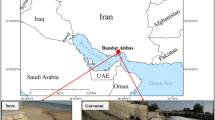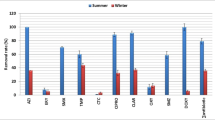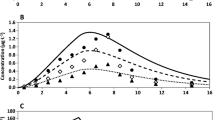Abstract
The main objective of the current study was to estimate the potential environmental risks associated with human consumption of antimicrobials in Greece. Consumption data was collected for the 24 most often used antimicrobials for the years 2008–2010, and their predicted environmental concentrations (PECs) in raw and treated wastewater were calculated using mass balances and literature data on human excretion and elimination efficiency during wastewater treatment. The ecotoxicological risk was estimated by calculating the ratio of PEC to predicted no-effect concentration (PNEC) for three categories of aquatic organisms (algae, daphnids, and fish). PNEC values were calculated based on experimental ecotoxicity data and data originated from the Ecological Structure Activity Relationship (ECOSAR). PEC values in raw sewage ranged between 0.02 μg L−1 (erythromycin) and 27 μg L−1 (amoxicillin), while in treated wastewater, the highest concentration was predicted for cefuroxime axetil (6.6 μg L−1). Based on acute toxicity data for algae, risk quotient (RQ) values higher than 1 were obtained for 7 out of the 24 target antimicrobials in raw and treated wastewater, while no significant risk was estimated for daphnids and fish. Regarding the possible risk due to the chronic toxicity of antimicrobials, RQ values higher than 80 were obtained for amoxicillin and clarithromycin in algae. The use of baseline toxicity data from ECOSAR showed that the environmental risk from exposure to mixtures of antimicrobials was low for all three aquatic species. However, further studies on toxicity of mixtures should be performed as calculation of toxicity ratio (TR) values showed that 90 % of the target antimicrobials seem to exhibit a specific mode of toxic action when present in mixtures rather than baseline toxicity. As a result, an underestimation of toxicity based on the ECOSAR model is possible for the mixture of target antimicrobials. For Greek rivers where low (dilution factor, D < 10) and medium (D = 10–100) dilution of wastewater occurs, moderate to high risk is expected due to the existence of individual antimicrobials such as amoxicillin, clarithromycin, ciprofloxacin, azithromycin, erythromycin, and levofloxacin in discharged treated wastewater.

Similar content being viewed by others
References
Andreozzi R, Caprio V, Ciniglia C, De Champdore M, Lo Giudice R, Marotta R, Zuccato E (2004) Antibiotics in the environment: occurrence in Italian STPs, fate, and preliminary assessment on algal toxicity of amoxicillin. Environ Sci Technol 38:6832–6838
Besse JP, Latour JF, Garric J (2012) Anticancer drugs in surface waters. What can we say about the occurrence and environmental significance of cytotoxic, cytostatic and endocrine therapy drugs? Environ Int 39:73–86
Botitsi E, Frosyni C, Tsipi D (2007) Determination of pharmaceuticals from different therapeutic classes in wastewaters by liquid chromatography–electrospray ionization–tandem mass spectrometry. Anal Bioanal Chem 387:1317–1327
Carlsson C, Johansson AK, Alvan G, Bergman K, Kühler T (2006) Are pharmaceuticals potent environmental pollutants?: part I: environmental risk assessments of selected active pharmaceutical ingredients. Sci Total Environ 364:67–87
ECETOC (2001) Aquatic toxicity of mixtures. European Centre for Ecotoxicology and Toxicology of Chemicals. Brussels, Belgium
EMEA (2006) Guideline on the environmental risk assessment of medicinal products for human use CHMP/SWP/4447/00. The European Agency for the Evaluation of Medicinal. Products, London
Escher BI, Baumgartner R, Koller M, Treyer K, Lienert J, McArdell CS (2011) Environmental toxicology and risk assessment of pharmaceuticals from hospital wastewater. Water Res 45:75–92
European Commission (2003) Technical guidance document in support of Commission Directive 93/67/EEC on risk assessment for new notified substances, Commission Regulation (EC) No 1488/94 on risk assessment for existing substances, and Directive 98/8/EC of the European Parliament and of the Council concerning the placing of biocidal products on the market, part II. Office for Official Publications of the European Communities, Luxembourg, (n.d.)
Golet EM, Alder AC, Giger W (2002) Environmental exposure and risk assessment of fluoroquinolone antibacterial agents in wastewater and river water of the Glatt Valley Watershed, Switzerland. Environ Sci Technol 36:3645–51
González-Pleiter M, Gonzalo S, Rodea-Palomares I, Leganés F, Rosal R, Boltes K, Marco E, Fernández-Piñas F (2013) Toxicity of five antibiotics and their mixtures towards photosynthetic aquatic organisms: implications for environmental risk assessment. Water Res 47:2050–2064
Grung M, Kallqvist T, Sakshaug S, Skurtveit S, Thomas KV (2008) Environmental assessment of Norwegian priority pharmaceuticals based on the EMEA guideline. Ecotox Environ Saf 71:328–340
Halling-Sørensen B, Nors Nielsen S, Lanzky PF, Ingerslev F, Holten Lützhoft HC, Jorgensen SE (1998) Occurrence, fate and effects of pharmaceutical substances in the environment—a review. Chemosphere 36:357–393
Jones OAH, Voulvoulis N, Lester JN (2002) Aquatic environmental assessment of the top 25 English prescription pharmaceuticals. Water Res 36:5013–5022
Kosma CI, Lambropoulou DA, Albanis TA (2014) Investigation of PPCPs in wastewater treatment plants in Greece: occurrence, removal and environmental risk assessment. Sci Total Environ 466–467:421–438
Lee YJ, Lee SE, Lee DS, Kim YH (2008) Risk assessment of human antibiotics in Korean aquatic environment. Environ Toxicol Pharma 26:216–221
Margiotta-Casaluci L, Hannah RE, Sumpter JP (2013) Mode of action of human pharmaceuticals in fish: the effects of the 5-alpha-reductase inhibitor, dutasteride, on reproduction as a case study. Aquatic Toxicol 128–129:113–123
Michael I, Rizzo L, McArdell CS, Manaia CM, Merlin C, Schwartz T, Dagot C (2013) Urban wastewater treatment plants as hotspots for the release of antibiotics in the environment: a review. Water Res 47:957–995
Neuwoehner J, Fenner K, Escher BI (2009) Physiological modes of action of fluoxetine and its human metabolites in algae. Environ Sci Technol 43:6830–6837
Ortiz de García S, Pinto Pinto G, García Encina P, Irusta Mata R (2013) Consumption and occurrence of pharmaceutical and personal care products in the aquatic environment in Spain. Sci Total Environ 444:451–465
Ratola N, Cincinelli A, Alves A, Katsoyiannis A (2012) Occurrence of organic microcontaminants in the wastewater treatment process. A mini review. J Haz Mater 239–240:1–18
Saling P, Maisch R, Silvani M, König N (2005) Assessing the environmental-hazard potential for life cycle assessment, eco-efficiency and SEE balance®. Int J Life Cycle Assess 10:364–371
Stuer-Lauridsen F, Birkved M, Hansen LP, Holten Lützhøft HC, Halling-Sørensen B (2000) Environmental risk assessment of human pharmaceuticals in Denmark after normal therapeutic use. Chemosphere 40:783–793
Thanh Thuy HT, Nguyen TD (2013) The potential environmental risks of pharmaceuticals in Vietnamese aquatic systems: case study of antibiotics and synthetic hormones. Environ Sci Poll Res 20:8132–8140
Turkdogan FI, Yetilmezsoy K (2009) Appraisal of potential environmental risks associated with human antibiotic consumption in Turkey. J Haz Mater 166:297–308
Van Wezel ΑP, Opperhuizen A (1995) Narcosis due to environmental pollutants in aquatic organisms: residue-based toxicity, mechanisms, and membrane burdens. Crit Rev Toxicol 25:255–79
Verhaar HJM, van Leeuwen CJ, Hermens JLM (1992) Classifying environmental pollutants. 1: Structure-activity relationships for prediction of aquatic toxicity. Chemosphere 25:471–491
Xu H, Cooper WJ, Jung J, Song W (2011) Photosensitized degradation of amoxicillin in natural organic matter isolate solutions. Water Res 45:632–638
Zhang T, Li B (2011) Occurrence, transformation, and fate of antibiotics in municipal wastewater treatment plants. Crit Rev Environ Sci Technol 41:951–998
Acknowledgments
The authors would like to thank Greece IMS Health Incorporation for the offer of antimicrobials consumption data for the years 2008, 2009, and 2010. This research has been co‐financed by the European Union (European Social Fund—ESF) and Greek national funds through the Operational Program “Education and Lifelong Learning” of the National Strategic Reference Framework (NSRF)—Research Funding Program: THALES: Investing in knowledge society through the European Social Fund. WATERMICROPOL (www.aegean.gr/environment/watermicropol).
Author information
Authors and Affiliations
Corresponding author
Additional information
Responsible editor: Markus Hecker
Rights and permissions
About this article
Cite this article
Iatrou, E.I., Stasinakis, A.S. & Thomaidis, N.S. Consumption-based approach for predicting environmental risk in Greece due to the presence of antimicrobials in domestic wastewater. Environ Sci Pollut Res 21, 12941–12950 (2014). https://doi.org/10.1007/s11356-014-3243-7
Received:
Accepted:
Published:
Issue Date:
DOI: https://doi.org/10.1007/s11356-014-3243-7




